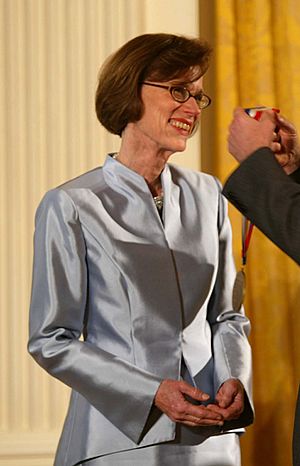Ann Graybiel facts for kids
Quick facts for kids
Ann Martin Graybiel
|
|
|---|---|

Graybiel receives the Medal of Science from President George W. Bush in 2001.
|
|
| Born | 1942 Chestnut Hill, Massachusetts
|
| Alma mater |
|
| Occupation | Neuroscientist |
| Known for |
|
| Awards |
|
Ann Martin Graybiel (born 1942) is a famous American neuroscientist. She is a professor at the Massachusetts Institute of Technology (MIT) and an investigator at the McGovern Institute for Brain Research.
Graybiel is an expert on a part of the brain called the basal ganglia. This area helps control our movements, thoughts, and habits. Her work has helped us understand conditions like Parkinson's disease, Huntington's disease, and obsessive–compulsive disorder.
Contents
Brain Discoveries
For most of her career, Dr. Graybiel has studied the striatum. The striatum is a key part of the basal ganglia. It is involved in movement, learning new things, and forming habits.
Finding a Hidden Pattern
In the 1970s, scientists thought the striatum was just a simple bundle of brain cells. But Graybiel discovered this was not true. She found that the cells were organized into special groups, which she named striosomes.
Later, she found that problems with these striosomes are linked to brain disorders. For example, changes in striosomes can affect mood in people with Huntington's disease. They are also related to the loss of a chemical called dopamine in Parkinson's disease.
How Habits Are Formed
Graybiel's research also showed how the striatum helps us learn and form habits. She discovered another set of cell clusters called matrisomes. These matrisomes connect different parts of the brain together. They create loops that link the part of the brain for thinking (the neocortex) to the part that coordinates movement (the brain stem).
By studying animals, she found that these matrisomes are very important for creating habits. When we repeat an action over and over, our brain creates a "chunk" of activity. Neurons fire at the beginning and end of the habit, but are quiet in the middle. This makes the habit automatic, so we don't have to think about it.
Career and Education
Ann Graybiel studied biology and chemistry at Harvard University and graduated in 1964. She then earned a master's degree from Tufts University. In 1971, she received her PhD in psychology and brain science from MIT. She became a professor at MIT in 1973.
In 1994, Graybiel and 15 other women professors at MIT wrote a letter to the school's leaders. They pointed out that women scientists were not being treated as fairly as men. This helped start a movement to make sure everyone at MIT had equal opportunities.
She became an Investigator at the MIT McGovern Institute for Brain Research in 2001. In 2008, she was given the title of Institute Professor, which is the highest honor for a professor at MIT.
Awards and Honors
Dr. Graybiel has received many awards for her amazing work.
- In 2001, she was awarded the National Medal of Science, a top honor for scientists in the United States. She was recognized for her discoveries about the brain's anatomy and how it controls thought and movement.
- In 2012, she won the Kavli Prize in Neuroscience. She shared the prize with two other scientists for their work on how the brain understands the world and makes decisions.
- In 2018, she received the Gruber Prize in Neuroscience. The prize committee said her work completely changed how we study the basal ganglia.
A leader of the Gruber Prize committee said, "When these three extraordinary scientists began their careers, few people were paying much attention to the basal ganglia. Today, thanks to their pioneering research, we now recognize the central role that this area of the brain plays."
Graybiel is also a member of many respected science groups, including:
- The US National Academy of Sciences
- The American Academy of Arts and Sciences
- The American Philosophical Society
- The Norwegian Academy of Science and Letters
- The Royal Irish Academy (as of 2024)

